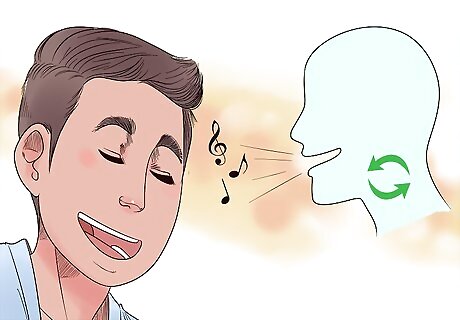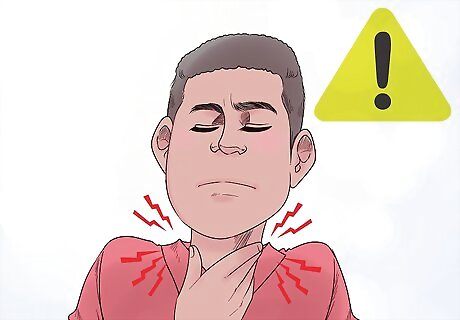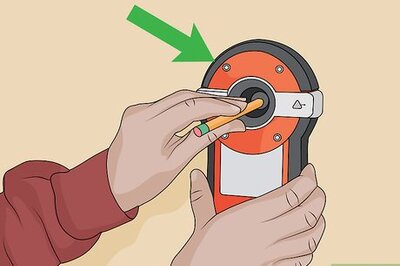
views
Positioning Your Body

Stand up as straight as possible. You'll have a hard time belting properly if your body is slouching. Hold your head up and place your feet shoulder-width apart so that you're comfortable yet strongly vertically aligned. You can keep your arms at your sides or wherever else they're comfortable.

Breathe from your diaphragm. Your diaphragm is located at the base of your lungs. Breathe deeply and feel the air filling up your lungs—you should feel this process in your chest. When you're breathing from your diaphragm, you're getting energy from your core which will help you power those notes. If you're not sure if you're breathing from your diaphragm, lay down on the floor and put one hand over your chest and the other hand across your stomach. Start taking deep breaths—if you're breathing from your diaphragm, the hand on your stomach should move while the hand on your chest remains still. Proper breath support is crucial for belting. Try yelling to determine how much air you need to make your voice loud and how your diaphragm contracts to release this air. Then, spend time finding out the proper amount of air and breath support needed for individual notes you belt.

Release all of your tension by shaking out your body. Belting puts tension on your vocal cords, to it's important to counteract this by relaxing the rest of your body as much as possible. Relax your shoulders and pull them back so you're standing up straight. Shake out your arms and legs if necessary so that your body loses any tension. You can also do some jumping jacks, stretch your arms up over your head as high as they'll go, or even try out some yoga to settle your muscles and mind. Aim to stay relaxed before, during, and after singing.
Practicing the Belting Technique

Keep your mouth open and your tongue down. The more you open your mouth, the better the sound you'll produce. Your voice needs to be able to fill up your entire mouth as it reverberates, and lowering your tongue so it's not in the way will help you produce a stronger sound as well. Relaxing -- not forcing -- your tongue down helps control the increase in air pressure happening in your mouth. Practice keeping your mouth open while singing and your tongue down until it becomes muscle memory.

Place your voice forward. Placing your voice forward is all about the concentration of resonance—you want the sound that you produce to resonate in the front of your face. To do this, try keeping your tongue at the bottom of your front teeth when singing. This may sound like you're yelling or whining at first, but you'll be able to produce a richer sound with time and practice.

Practice singing high notes in your chest voice. Your chest voice produces more volume more comfortably than your head voice. Breathe deeply and summon your voice from your chest, practicing singing notes higher and higher as you get better at belting. Be careful not to go too far above or below the range you can comfortably sing.

Sustain your belted notes by ensuring you have enough breath. If you use up all of your breath while you're singing, your voice will start to fade or crack. The less air that escapes through your air passage, the better you'll be able to belt. Imagine that you're breathing through a thin straw as you're singing, which will help you control the amount of air you use.
Doing Vocal Exercises

Practice your vocal strength by doing exercises. Doing exercises will help you learn to sing in different registers, such as the sounds that come from your chest voice and your head voice. Start by picking a sound and singing it in different notes, slowly making your voice higher and stronger. Your chest voice is the lower register, and your head voice is the upper register.

Say the word "hey" to practice bouncing your voice. Say the word "hey" out loud in a normal voice. Now continue saying hey, hearing the word bounce from your mouth, saying it in a higher voice next time. You can also say "hey" and expand it, turning it into more of a "heeeey." Make sure you're not yelling the word "hey"—it should be as similar to your normal speaking voice as possible.

Mimic the sound of a baby saying "wheh" to amplify your voice. When you say "wheh," the sound bounces off of your nasal pharynx, making your voice sound louder and almost as if it were coming out of your ears. Practice saying "wheh" repeatedly, drawing out the word, until you feel it reverberating next to your nose.

Practice engaging your core by repeating "ffft." Press your hands to the sides of your core so that you'll be able to feel it move. Make the "ffff" sound and then add a "t" sound at the end, almost as if you're saying "foot" without the 'oo' sound. You should feel your stomach contract when making the 'f' sound and go back out when the 't' sound comes. Draw out the 'f' as you progress to really feel your core being engaged.

Choose a sound and repeat it, singing a bit higher each time. You can sing "ah aah ah," "hm mmm mm," or any other sound as long as it has three syllables. The second syllable should be sung in a higher note than the first and third, and each time you repeat the whole phrase, go up an octave to really exercise your voice.
Establishing Good Habits

Find a place where you can be as loud as needed. If you're worried about making too much noise or disturbing others, you're not going to produce your best sound. Find a spot where you can sing as loudly as you like without holding anything back. This might be your room when others aren't home or a music room at a school or community center.

Practice belting in 20-minute increments a day. Trying to belt for hours at a time will hurt your voice, and you can risk developing nodes. Set a timer and practice for no more than 20 minutes. If you feel your voice starting to hurt or get scratchy before those 20 minutes are up, stop and try again tomorrow. You can practice belting every day, but keep it to 20 minutes each time. When resting your voice, spend time listening to vocalists who are great at belting and analyze their technique. You can also imagine what it feels like and sounds like when you're the one belting.
Exercise your entire range. Practice singing in both chest and head voice so that you strengthen and develop all parts of your voice. Sing notes from the bottom of your range to the top each time you practice.

Drink lots of water to keep your vocal cords loose and relaxed. Your vocal cords will become dry as you practice belting, so make sure you hydrate and drink plenty of water to ensure you don't produce a cracked or flat sound. Room-temperature water keeps your vocal cords loose, hydrated and relaxed, but even drinking cold water is better than no water at all. If your voice starts to hurt, consider going for some warm tea or gargling salt water.

Avoid forcing your voice beyond its capabilities. Belting should never cause pain or discomfort to your voice, throat, or any other part of your body. If it does hurt while you're practicing, stop immediately so that you don't cause any damage. If you start off by practicing exercises and working in small increments of time, your voice shouldn't hurt.



















Comments
0 comment